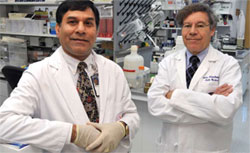Office of Research & Development |
 |


In 1856, a French clinician named Trousseau made a curious observation: He noted that many cancer patients had excess blood clotting. They would often develop clots in leg-muscle veins—a condition called deep vein thrombosis—or in other areas of the body.
Today, more than 150 years later, the connection between cancer and excess clotting is still largely a mystery to scientists. Does one condition raise the risk of the other? No one can say for sure. But the link is an intriguing clue for researchers like Mahesh Sharma, PhD, director of the Laboratory of Geriatric Endocrinology and Metabolism at the Washington, DC, VA Medical Center. He thinks the pathways involved in blood clotting may point to an important target for new cancer drugs.
"These are very old observations—this isn't new," says Sharma. "I'm just trying to put a puzzle together."
One thing scientists know for sure is that cancer is a hungry disease. It needs new blood vessels to feed it. When a solid tumor grows in the breast—or in the liver, kidney, colon, prostate, pancreas, or other organs—it is "off the grid," in a sense: It is cut off from the body's existing network of blood vessels. To grow and spread, the cancer demands its own "supply route" in the form of new blood vessels.
Clotting goes hand in hand with the growth of new vessels, also known as neoangiogenesis. When a clot forms in a vein or artery, the body instinctively fears a life-threatening stroke or heart attack. It sets in motion a cascade of proteins to break down the clot—and to restore blood flow around the area of the clot, as an extra precaution. "This is nature's response to protect the host from the catastrophe of blood clotting," says Sharma.
This restoration of blood flow includes the formation of new blood vessels. And this, notes Sharma, "is just what the cancer wants." In fact, cancer unleashes proteins to aid the clotting and neoangiogenesis process. In essence, it hijacks the body's biochemical pathways for its own gain.
Researchers worldwide are attacking the problem from many angles. Sharma's studies over the past decade have led him to focus on a protein called annexin 2, part of the clotting pathway. It helps make an enzyme, plasmin, that acts like a scissor to cut existing vessels with clots. This in turn triggers blood cells to form new vessels.
Unlike other proteins involved in this chain reaction, annexin 2 appears to be activated only when cancer is present. That makes it a prime target for a cancer-killing drug.
When Sharma's group tested breast tissue taken from 150 women with breast cancer, they found "consistently that annexin 2 is correlated with disease progression. Higher levels of annexin 2 correlated with more blood vessels forming, leading to more invasive and metastatic cancer." In contrast, women without cancer showed no annexin 2 in their breast tissue.
Other studies around the world support the idea that annexin 2 is a key culprit in cancer. In one German trial, researchers found that the higher the level of annexin 2 in patients' tumors, the sooner the patients succumbed to the disease. Sharma believes that if annexin 2 can be blocked—thereby stopping the growth of new blood vessels to support the tumor—the cancer will starve to death.
His lab has developed synthetic antibodies to do the job. They block annexin 2 and thereby thwart the production of plasmin, the enzyme that causes new blood vessels to grow.
Specifically, the type of antibodies being used are monoclonal antibodies, so named because they are copied from one type of antibody found naturally in the human immune system. They seek out and destroy one protein—in this case, annexin 2, or ANX II for short.
In a recent mouse experiment by Sharma's group, sponsored by the Department of Defense, the antibodies had a dramatic effect. "There was a 60 to 70 percent reduction in angiogenesis and tumor growth," says Sharma. The findings appear in the February 2012 issue of Experimental and Molecular Pathology.
The study used a technique called xenografting: Human tumors were transplanted into mice that were genetically engineered to lack an immune system, so they could not reject the foreign tissue. The method is thought to be more useful than studying an agent's effect on cancer cells in a Petri dish, or on a tumor that originates within an animal. Still, there's no telling at this point how the therapy would actually work in people. Further studies will be needed before Sharma's group can test the therapy in a human clinical trial.
In fact, even as he looks optimistically to the future of his anti-ANX II antibodies, Sharma sounds a note of caution: He warns that while the mice in his lab showed no adverse effects from the therapy, it could potentially cause complications in humans. For example, it could interfere with normal blood clotting. He admits that there would be little advantage in beating back cancer if the patient would become at risk from bleeding to death from a wound—as in hemophilia.
"These are important questions to answer," acknowledges Sharma.
For now, his group wants to try to replicate findings from studies such as the German trial mentioned above by following patients being treated for breast cancer. How closely do their levels of annexin 2 predict their survival rate? Are the levels tied to genetic factors such as the presence of the breast-cancer risk genes BRCA1 and BRCA2? Sharma notes that while annexin 2 clearly plays a role in many forms of cancer, he plans to stay focused on breast cancer, especially in light of VA's growing population of women Veterans.